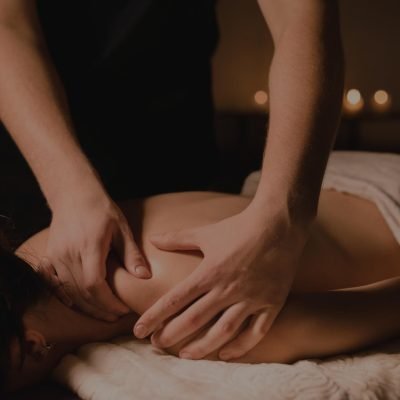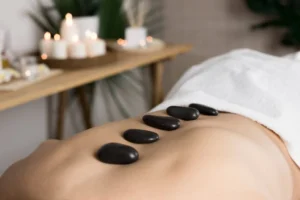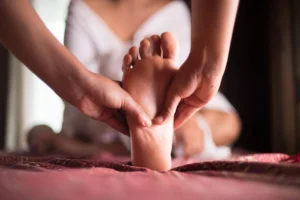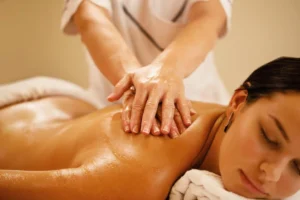
Are you looking for a gift that combines romance with genuine relaxation? A couples massage as a gift is more than an ordinary present—it is
Balinese massage is one of the most recognizable relaxation techniques, originating from traditional Indonesian medicine. This unique therapeutic method combines elements of acupressure, reflexology, and aromatherapy, offering a holistic approach to body regeneration. Traditional Balinese massage is characterized by gentle yet deeply effective work on tense muscles and energy points. The technique incorporates a variety of movements – from soothing strokes to more intensive kneading of tissues. During the treatment, the therapist uses natural essential oils, which enhance relaxation and support skin rejuvenation.
To fully understand Balinese massage, one must view it through the lens of holistic health, where the body is treated as a unity that requires balance between the physical and mental spheres. This therapy not only relieves muscle tension but also improves blood and lymph circulation while supporting the body’s detoxification processes.
The beginnings of this technique date back to ancient Balinese traditions, where massage was an integral part of daily life. Balinese massage promotes health, based on the belief that the human body is a temple of the spirit, deserving the utmost care. The philosophy behind this practice assumes that physical ailments stem from disturbances in the natural flow of life energy throughout the body. Traditional Balinese healers believe that massage can restore energetic balance and release blockages caused by stress or unhealthy lifestyle habits.
This technique has been passed down through generations, enriched with new elements and adapted to modern needs. Balinese massage has gained global recognition for its effectiveness in relieving tension and its ability to induce profound relaxation. At Lumira SPA, you can experience professional treatments performed in line with authentic Balinese tradition.
Balinese massage can best be described as a journey through different layers of sensations and experiences. Each session begins with a brief consultation, during which the therapist discusses the client’s expectations and any health contraindications. The client is then invited to lie comfortably on a massage table, where full relaxation is possible.
The treatment starts with gentle warming strokes to prepare the muscles for deeper techniques. Gradually, the therapist increases the intensity, moving into kneading methods. Throughout the session, specially selected essential oils are used to facilitate movements and enhance the sensory experience through aromatherapy.
The benefits of Balinese massage can be felt as early as the first session – muscles become relaxed, and the mind enters a deep state of tranquility.
Regular sessions bring multifaceted benefits for both physical and mental well-being. Primarily, Balinese massage effectively reduces muscle tension caused by stress, prolonged sitting, or intense physical activity. The technique stimulates blood and lymph circulation, which supports detoxification processes and accelerates tissue regeneration.
Its deep work on muscles and reflex points alleviates back, neck, and headache pain often experienced by people with sedentary lifestyles. On a neurological level, Balinese massage lowers the stress hormone cortisol while stimulating the release of endorphins – hormones responsible for feelings of happiness and relaxation.
Additionally, the treatment improves tissue elasticity and increases the range of motion, making it especially valuable for physically active individuals. The aromatherapeutic properties of essential oils further enhance mental well-being, aiding in the treatment of insomnia and anxiety.
Traditional Balinese massage stands out for its unique combination of techniques drawn from various therapeutic traditions. Central to the practice are long, flowing strokes along the muscles, inducing relaxation and preparing the body for deeper work.
Another characteristic element is rhythmic kneading and compression, which improves circulation and helps release tension from deeper muscle layers. Therapists also employ acupressure, applying precise pressure to energy points with the goal of restoring the body’s natural flow of energy.
The essence of Balinese massage lies in its calm, meditative rhythm, which naturally induces deep relaxation. The therapist works with the entire body, integrating massage techniques with elements of yoga and muscle stretching, helping to restore the body’s natural harmony.

Although Balinese massage is generally considered a safe form of therapy, there are certain situations where caution should be exercised or the treatment should be avoided altogether. Contraindications to Balinese massage include acute inflammation, fever, and infections, during which the body requires rest and should not be additionally stimulated. Individuals with serious cardiovascular conditions, such as deep vein thrombosis or heart failure, should consult their physician before undergoing the treatment. Malignant tumors, particularly in the active phase, are an absolute contraindication to massage. Pregnant women may benefit from this form of therapy; however, they should inform the therapist, who will adjust the techniques accordingly and avoid the abdominal and lower back areas.
Fresh injuries, fractures, or post-surgical conditions require individual assessment and, in some cases, medical consultation before proceeding with the massage. People with skin conditions such as eczema or psoriasis in the acute phase should also exercise caution, as the treatment may irritate affected areas.
Proper preparation for a Balinese massage significantly enhances both comfort and effectiveness of the session. It is recommended to avoid heavy meals for at least two hours before the planned treatment, allowing the body to fully relax without burdening the digestive system. Prior to the massage, it is also advisable to refrain from consuming alcohol and large amounts of caffeine, as they may affect muscle tension and the ability to relax.
The benefits of Balinese massage can be fully appreciated when the body is well-hydrated; therefore, drinking sufficient water before and after the session is highly recommended. Following the massage, it is best to avoid intense physical activity and stressful situations to prolong the positive effects of the therapy. Drinking plenty of water after the treatment supports detoxification processes and helps flush out metabolites released from the tissues during the massage. If you are planning regular sessions, consider purchasing a voucher to enjoy the benefits of this exceptional therapy at an attractive price.

Lumira Spa is a place where relaxation takes on a unique dimension. Experienced therapists from Asia offer signature rituals and massages inspired by Thai and Balinese traditions. Each of them honed their skills at prestigious schools in the Philippines and under the guidance of masters, combining their knowledge with over a decade of practice. Guests can enjoy massages, scrubs, and baths that nurture the body, mind, and spirit. The spa provides a comfortable and soothing atmosphere for both individual and paired experiences.

Are you looking for a gift that combines romance with genuine relaxation? A couples massage as a gift is more than an ordinary present—it is

Pregnancy is a time when a woman’s body undergoes significant changes – the spine is under increased strain, legs may swell, and muscles often become

Therapeutic massage is one of the oldest therapeutic methods, which has evolved over the centuries, becoming today an integral part of physiotherapy and rehabilitation. This

Hot stone massage is one of the oldest relaxation techniques, combining the power of touch with the natural warmth of lava stones. This unique form

Regular care for health and well-being increasingly includes natural methods of supporting the body. One such practice is reflexology, a special form of bodywork that

Balinese Massage – Origins, Philosophy, and Benefits Balinese massage is one of the most recognizable relaxation techniques, originating from traditional Indonesian medicine. This unique therapeutic